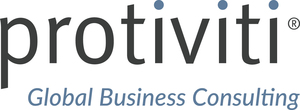MENLO PARK, Calif., July 20, 2017 /PRNewswire/ -- According to a new procurement study by global consulting firm Protiviti, nearly half of finance leaders claim that 20 percent or less of procurement savings wind up dropping to their companies' bottom line. Amidst a business environment where monetary returns, business value and financial risk are under intense scrutiny, the survey report highlights a clear disconnect between corporate finance and procurement in the perceived value contributed by the procurement function to an organization's profitability.
The Protiviti survey report, Bridging the Gap between Finance and Procurement, is based on an in-depth survey of 440 finance and procurement executives, who were asked for their views on procurement's performance and value. The survey was conducted in the first quarter of 2017, and 41 percent of respondents' organizations have revenues of $1 billion or more. The survey was motivated by the frequency with which Protiviti observes opposing assessments of procurement's performance by these leaders.
According to the survey findings, the perceived disconnect stems from the way procurement functions track and communicate savings, as well as how they collaborate with finance departments and work with the business to ensure these savings positively affect the bottom line. Forty-one percent of those surveyed say that although procurement savings are being tracked (overall, less than half actually track absolute savings), the measurement and value are not being articulated across the organization. In addition, just over one in three view the working relationship between finance and procurement as collaborative, suggesting much room for improvement.
"A synergistic finance-procurement relationship appears aspirational for most organizations, as few are currently living up to this ideal," said Bernie Donachie, a Protiviti managing director and leader of the firm's supply chain practice. "Although the two functions are not seeing eye-to-eye in terms of procurement's performance or the value it delivers, it's demonstrably clear that procurement functions have an opportunity to focus on how they drive value and quantify and communicate their performance across their organizations, which can lead to improved profitability."
"Our research showed that most organizations need to work on savings-to-P&L traceability," said Tony Abel, a Protiviti managing director and a leader within the supply chain practice. "Fewer than half of procurement leaders rate their function as 'very effective' in reporting and promoting the savings it delivers. The views of finance leaders are significantly less positive still."
However, of the 16 percent of procurement departments that are viewed internally by executives as profit centers, there are several common noteworthy characteristics, including:
- Utilizing spend analysis within budgeting and planning functions (85 percent)
- Using third-party tools to conduct spend analyses (55 percent)
- Tracking achieved savings generated by procurement (92 percent)
- Including cash flow and working capital as key elements of procurement savings goals (82 percent)
"Based on our analysis of the findings, a distinct set of traits emerge when comparing higher-performing procurement functions to lower-performing functions," said Christopher Monk, a managing director with Protiviti and a leader within the supply chain practice. "Procurement can drive visible value across their organizations by improving their spend analysis capabilities and tools; centralizing core activities; and including cash flow and working capital as part of overall savings goals, thereby turning negotiated savings into realized savings that impact the bottom line. An added benefit of putting these best practices into motion is to bolster procurement's credibility throughout the enterprise."
Survey Report and Infographic Available
Detailed findings about the study's results can be found in the Protiviti 2017 procurement report, available for complimentary download here. Also available on the site is an infographic with survey highlights. For more information about Protiviti's procurement consulting services, please click here.
About Protiviti Inc.
Protiviti (www.protiviti.com) is a global consulting firm that delivers deep expertise, objective insights, a tailored approach and unparalleled collaboration to help leaders confidently face the future. Protiviti and our independently owned Member Firms provide consulting solutions in finance, technology, operations, data, analytics, governance, risk and internal audit to our clients through our network of more than 70 offices in over 20 countries.
Protiviti has served more than 60 percent of Fortune 1000® and 35 percent of Fortune Global 500® companies. Protiviti also works with smaller, growing companies, including those looking to go public, as well as with government agencies. Protiviti is a wholly owned subsidiary of Robert Half (NYSE: RHI). Founded in 1948, Robert Half is a member of the S&P 500 index.
Protiviti is not licensed or registered as a public accounting firm and does not issue opinions on financial statements or offer attestation services.
Editor's Note: Infographic (in JPEG and PDF) and photos available upon request.
SOURCE Protiviti
Related Links
WANT YOUR COMPANY'S NEWS FEATURED ON PRNEWSWIRE.COM?
Newsrooms &
Influencers
Digital Media
Outlets
Journalists
Opted In





Share this article